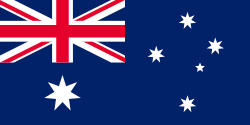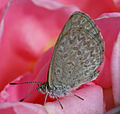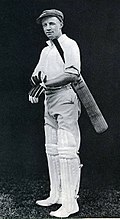Portal:Australia
| Showcase | Content | Interesting facts | Contributing |
Introduction

Australia, officially the Commonwealth of Australia, is a country comprising the mainland of the Australian continent, the island of Tasmania and numerous smaller islands. It has a total area of 7,688,287 km2 (2,968,464 sq mi), making it the sixth-largest country in the world and the largest in Oceania. Australia is the world's flattest and driest inhabited continent. It is a megadiverse country, and its size gives it a wide variety of landscapes and climates including deserts in the interior and tropical rainforests along the coast.
The ancestors of Aboriginal Australians began arriving from south-east Asia 50,000 to 65,000 years ago, during the last glacial period. By the time of British settlement, Aboriginal Australians spoke 250 distinct languages and had one of the oldest living cultures in the world. Australia's written history commenced with Dutch exploration of most of the coastline in the 17th century. British colonisation began in 1788 with the establishment of the penal colony of New South Wales. By the mid-19th century, most of the continent had been explored by European settlers and five additional self-governing British colonies were established, each gaining responsible government by 1890. The colonies federated in 1901, forming the Commonwealth of Australia. This continued a process of increasing autonomy from the United Kingdom, highlighted by the Statute of Westminster Adoption Act 1942, and culminating in the Australia Acts of 1986.
Australia is a federal parliamentary democracy and constitutional monarchy comprising six states and ten territories. Its population of almost 28 million is highly urbanised and heavily concentrated on the eastern seaboard. Canberra is the nation's capital, while its most populous cities are Sydney and Melbourne, both with a population of more than 5 million. Australia's culture is diverse, and the country has one of the highest foreign-born populations in the world. It has a highly developed economy and one of the highest per capita incomes globally. Its abundant natural resources and well-developed international trade relations are crucial to the country's economy. It ranks highly for quality of life, health, education, economic freedom, civil liberties and political rights.
Featured article -

The history of the Royal Australian Navy traces the development of the Royal Australian Navy (RAN) from the colonisation of Australia by the British in 1788. Until 1859, vessels of the Royal Navy made frequent trips to the new colonies. In 1859, the Australia Squadron was formed as a separate squadron and remained in Australia until 1913. Until Federation, five of the six Australian colonies operated their own colonial naval force, which formed on 1 March 1901 the Australian Navy's (AN) Commonwealth Naval Force which received Royal patronage in July 1911 and was from that time referred to as Royal Australian Navy (RAN). On 4 October 1913 the new replacement fleet for the foundation fleet of 1901 steamed through Sydney Heads for the first time. (Full article...)
Selected biography -
William Henry Kibby, VC (15 April 1903 – 31 October 1942) was a British-born Australian recipient of the Victoria Cross, the highest award for gallantry in the face of the enemy that could be awarded to a member of the Australian armed forces at the time. Kibby emigrated to South Australia with his parents in early 1914 and worked as an interior decorator and served in the part-time Militia prior to World War II. In 1940, he enlisted in the all-volunteer Second Australian Imperial Force and joined the 2/48th Infantry Battalion. His unit was sent to the Middle East, but soon after arriving, Kibby broke his leg and spent the next year recovering and undergoing further training while his battalion took part in the North African campaign. He rejoined his unit when it was serving on garrison duties in northern Syria after its involvement in the siege of Tobruk, but in June 1942 it was sent to Egypt and recommitted to the North Africa campaign. Kibby was with the battalion during the First Battle of El Alamein in July. (Full article...)
Did you know (auto-generated) -
- ... that the government of Victoria, Australia, has a program to remove 110 level crossings by 2030, the fastest rate in the state's history?
- ... that Australian politicians may face the pub test?
- ... that the United Ukrainian Ballet Company, consisting of exiled dancers based in The Hague, has toured the UK, Singapore, Australia and the US?
- ... that Turkish international soccer player Rojin Polat was named member of the "2021 All Schools Merit Girls Team" in New South Wales, Australia?
- ... that the Greco-Australian dialect, a variety of Modern Greek, blends words with English roots into the Greek language?
- ... that a newspaper in Kentucky reported that the solar eclipse of November 22, 1900, would pass over Austria instead of Australia?
- ... that Scottish painter Gordon Coutts left Australia without paying maintenance to his estranged wife, but was arrested in New Zealand?
- ... that Mark Hutton was the first Australian to be a starting pitcher in a Major League Baseball game?
In the news
- 2 April 2025 – Tariffs in the second Trump administration
- In the 10% tariff, the U.S. lists the Australian territory of Heard Island and McDonald Islands near Antarctica, despite the fact that it has no human inhabitants, imports or exports. In response to finding these islands in the list, Australian prime minister Anthony Albanese commented that "Nowhere on earth is safe" for the tariff. (The Guardian)
- 31 March 2025 – Australia–North Korea relations
- The Royal Australian Air Force deploys a long-range maritime patrol aircraft P-8 Poseidon to Kadena Air Base in Okinawa Prefecture, Japan, to monitor North Korean maritime activities in the Yellow Sea, including weapons shipments prohibited under international sanctions. (NK News)
- 8 March 2025 – 2024–25 Australian region cyclone season
- Cyclone Alfred
- One person is confirmed killed and thirteen others are injured in floods caused by Cyclone Alfred as it passes through Queensland and New South Wales, Australia. (AP)
- 5 March 2025 – 2024–25 Australian region cyclone season
- Tropical Cyclone Alfred
- Queensland Premier David Crisafulli announces the suspension of public transport services and the closure of 640 schools in South East Queensland, Australia, as Cyclone Alfred is expected to make landfall early Friday morning local time. (ABC News Australia)
Selected pictures -
On this day

- 1932 – Racehorse Phar Lap is found dead.
- 1933 – Anthropologist and protector of Aborigines Walter Edmund Roth dies.
- 2004 – Australia's biggest supplier to the farming community of the potential explosive ammonium nitrate decides to pull the product from its stores in response to concerns it could be used by terrorists.
General images
Topics
More portals
WikiProject
 |
 |

| |
Consider joining WikiProject Australia, a WikiProject dedicated to improving Wikipedia's coverage of topics related to Australia. The project page and its subpages contain suggestions on formatting and style of articles, which can be discussed at the project's notice board. To participate, simply add your name to the project members page.
As of 4 April 2025, there are 207,751 articles within the scope of WikiProject Australia, of which 598 are featured and 894 are good articles. This makes up 2.98% of the articles on Wikipedia, 5.27% of all featured articles and lists, and 2.16% of all good articles (see WP:AUSFG). Including non-article pages, such as talk pages, redirects, categories, etc., there are 415,502 pages in the project.
Associated Wikimedia
The following Wikimedia Foundation sister projects provide more on this subject:
-
Commons
Free media repository -
Wikibooks
Free textbooks and manuals -
Wikidata
Free knowledge base -
Wikinews
Free-content news -
Wikiquote
Collection of quotations -
Wikisource
Free-content library -
Wikiversity
Free learning tools -
Wikivoyage
Free travel guide -
Wiktionary
Dictionary and thesaurus








































































































